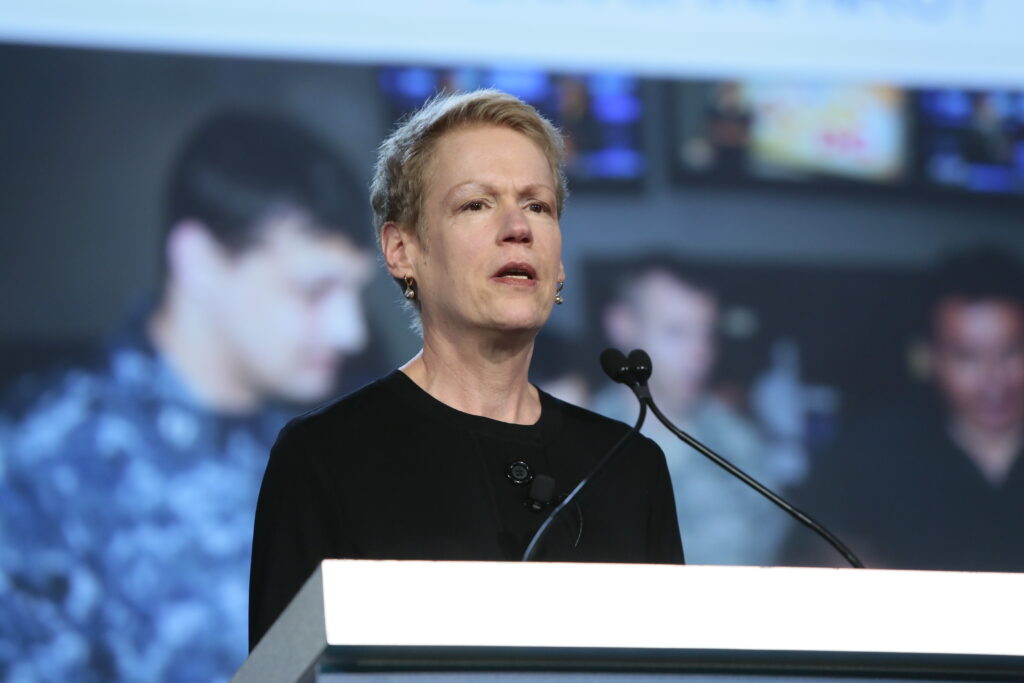
Betty Sapp, NRO Director, GEOINT 2016
WASHINGTON: America’s spy satellite maker and operator, the National Reconnaissance Office, has one major satellite program at risk of not meeting its cost and schedule requirements, its director Betty Sapp says.
In a rare moment of transparency, Sapp answered my question about the status of the agency’s programs at the Intelligence and National Security Summit on Sept. 8. This particular program is rated “yellow,” Sapp said, which generally means it is at moderate risk of breaching cost and schedule baselines. The DNRO also noted that while her agency has suffered serious acquisition problems in the past, “we’ve always done well on performance. Cost and schedule, not so much in the past, but we’ve changed that, and we’re doing very, very well.”
Director of National Intelligence James Clapper had told the summit one day before that most of the 27 major systems acquisition programs being built by the Intelligence Community are “in the green,” which means they’re meeting their cost, performance and schedule goals.
NRO spokeswoman Loretta DeSio provided a bit more clarity about whether it was cost or schedule (or both) at risk in a statement she sent via email: “As Director Sapp publicly stated yesterday, it is true that only 1 of our 17 major systems acquisitions is behind schedule, and that system should be delivered very soon.”
As my colleague Mike Gruss at Space News mentioned in his story about this, Sapp presented a slide In June 2015 “that suggested 11 of 12 unnamed programs were on budget, with one exceeding costs by about 6 percent.” Because of the NRO’s lack of transparency, we don’t know if this is the same program or not.
Of the 27 major intelligence community programs Clapper said were mostly green — though “therea re certain exceptions to that” — 17 are in the hands of the NRO. So I asked Sapp how many of her programs were not in the green. I also asked if the primary problems were cost or schedule or both (the question DeSio later answered). Director Sapp didn’t offer any more details, as is her wont.
“The notion that we should be more transparent about who we are and what we do makes a lot of sense,” Sapp said in May at the GEOINT conference. Of course, astute readers will not she didn’t say she would make the agency any more transparent. While Sapp has said in public forums that she is committed to more transparency, there is little evidence of this.
As someone who has covered five NRO directors, going back to Pete Teets, I can say that the NRO provides the public with less information about its programs and engages with the press (and thus the public) under Sapp than under any other of those directors’ tenure.
DeSio wrote this in response to my observations about the NRO’s transparency under Sapp: “While we cannot share the details of the innovative overhead systems the NRO develops and deploys – for obvious reasons – we will continue to engage with media outlets, trade publications, and the public to the maximum extent practical.”
There was a priceless moment at the summit when Sapp, sitting next to NGA director Robert Cardillo, made clear just how much she values her public appearances. (Speeches and Q and A sessions are the main way the NRO and most other intelligence agencies communicate useful information to the public.) Cardillo said how much he enjoyed and valued appearing at the INSA and AFCEA conference and they should do them more often. Sapp looked wryly at him, shook her head and clearly said, “no.”
In a Taiwan conflict, tough choices could come for Big Tech
Washington could do more to incentivize tech companies to distance themselves from China, but CEOs should examine how they’d react to a fight in the Pacific, CSET’s Sam Bresnick and Emelia Probasco argue.


























